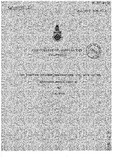- CERES Home
- →
- School of Engineering (SoE)
- →
- CoA. Notes: Materials (1963-1969)
- →
- View Item
JavaScript is disabled for your browser. Some features of this site may not work without it.
| dc.contributor.author | Smith, D. A. | |
| dc.date.accessioned | 2017-09-28T13:50:05Z | |
| dc.date.available | 2017-09-28T13:50:05Z | |
| dc.date.issued | 1968-08 | |
| dc.identifier.uri | http://dspace.lib.cranfield.ac.uk/handle/1826/12558 | |
| dc.description.abstract | Perfluoroglutaric acid when treated with methyl magnesium iodide afforded hexafluoro-2,6-dimethylpyran-2,6-diol in high yield and 2,213,3,4,4-hexafluoro- 5-oxocaproic acid in low yield. The former appeared to exist in a range melting form (61.-79°C) and also in a very labile form melting at 96-98°C. Problems associated with the formation of this latter form were investigated. The hexafluoro-2,6-dimethylpyran-2,6-diol yielded a monosemi-carbazone and also a mono and a di1(2,4-dinitrophenylhydrazone). The mono (2,4-dinitro phenylhydrazone) appeared to be cyclic. Reduction, both with lithium aluminium hydride and sodium borohydride yielded 3,3,4,415,5-hexafluoro-n-heptane-2,6-diol. Reaction with anhydrous calcium sulphate gave 3,3,414,515-hexafluoro-2- methylcyclohex-l-ene-6-one. The acid product of the original reaction of perfluoroglutaric acid and methyl magnesium iodide was characterised as a 2,4-dinitrophenylhydrazone and as an S-benzylthiouronium salt. Infra-red spectroscopic evidence suggests the latter compound exists in a straight chain form. | en_UK |
| dc.language.iso | en | en_UK |
| dc.publisher | College of Aeronautics | en_UK |
| dc.relation.ispartofseries | CoA/N/MAT-22 | en_UK |
| dc.relation.ispartofseries | 22 | en_UK |
| dc.title | The reaction of perfluoroglutaric acid with methyl magnesium iodide. Part 2 | en_UK |
| dc.type | Report | en_UK |
